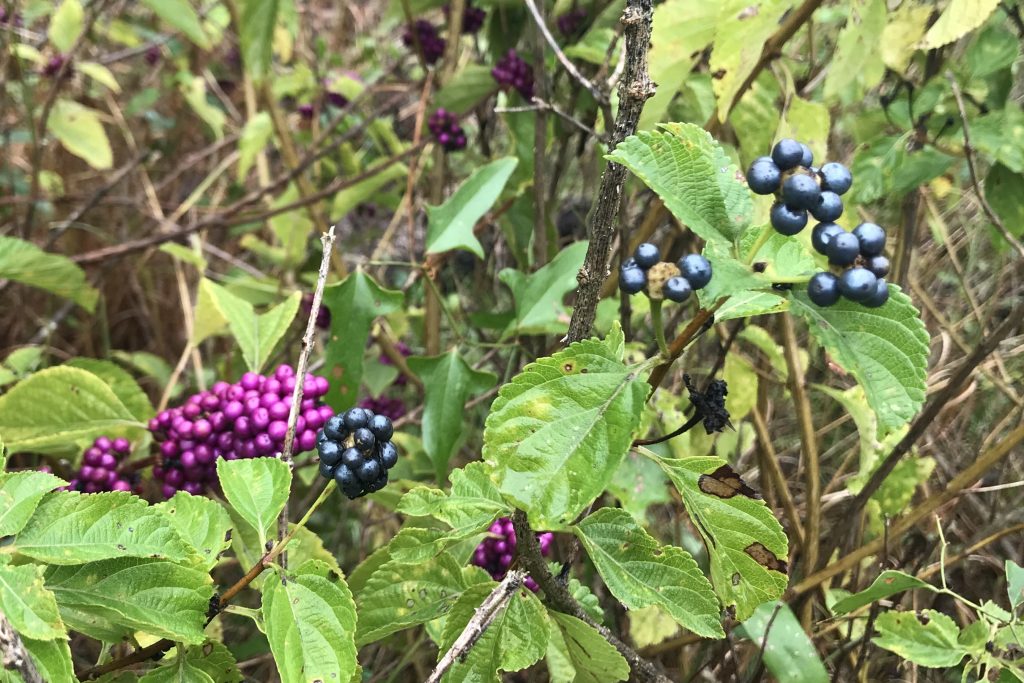
In Gainesville Saturday a colorful combination was worth a photograph: Pink American Beautyberries and blue Lantana berries. They were growing next to each other and the rain had stopped so it was a photo opportunity… didn’t cross my mind to eat them together as the blue ones are flavorful and the pink ones are not. Photo by Green Deane
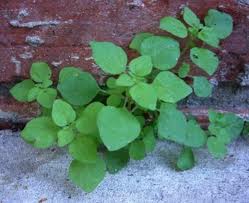
Pellitory is starting to peek out of it’s shady spots for the season. Photo by Green Deane
Weather ahead or behind schedule, or whether ahead or behind schedule, the plant season is changing into our winter mode. Controversial Brazilian Pepper is ripening and Cucumber Weed (Pellitory) has definitely started its seasonal run. We also saw some young False Hawk’s Beard and Poor Man’s Pepper Grass this weekend. Ringless Honey Mushrooms are in and out depending where you live. They were deliquescing (melting) in Gainesville but still flushing in Greater Orlando. What’s waiting in the winter wonderland to come up? Start looking for wild mustards and radishes and a couple of species of sow thistles.
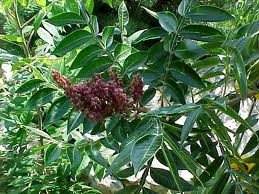
Edible Sumac has red clusters of berries on the end of branches and grows in dry places. Photo by Green Deane.
Some of you might have noticed I have been posting new videos (on You tube.) They have been Persimmons Revisited, Lantana, Tropical Almond Revisited and Sumac Revisited. I think Sea Grape is next. It’s been several years since I’ve posted videos regularly and some 13 years since the originals. Some of those species need to have a new video done. So that is on my agenda as I climb into my 70s. I’m aiming for a total of 200 videos… which means at least 45 more. Writing a foraing book took a chunk out of my life (to be released in 2023) and I’m just getting back onto the swing of things (and remembering how the video editing program works.) And of course while I am able there are foraging classes every weekend.
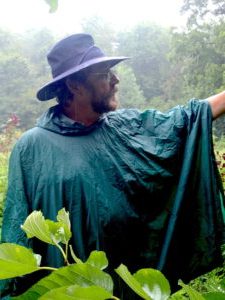
Classes are held rain or shine (but not during hurricanes.)
Foraging Classes: Some traveling this week, Ft. Pierce Saturday and close to home on Sunday in Winter Park.
Saturday November 13th, George LeStrange Preserve, 4911 Ralls Road, Fort Pierce, FL, 34981. 9 a.m. to noon. The preserve is only about three miles from the junction of the Turnpike and I-95. It has no bathrooms or drinking water so take advantage of the various eateries and gas stations at the exit.
Sunday November 14th, Mead Garden: 1500 S. Denning Dr., Winter Park, FL 32789. Meet at the bathrooms. The park entrance is on South Denning. Some GPS directions get it wrong.
Saturday November 20th, Eagle Park Lake, 1800 Keene Road, Largo, FL 33771. 9 a.m to noon. Meet at the pavilion by the dog park.
Sunday November 21st, Wickham Park: 2500 Parkway Drive, Melbourne, FL 32935-2335. 9 a.m. to noon. Meet at the “dog park” inside the park
Saturday December 4th, Bayshore Live Oak Park, Bayshore Drive. Port Charlotte. 9 a.m. to noon. Meet at the parking lot of Bayshore and Ganyard St.
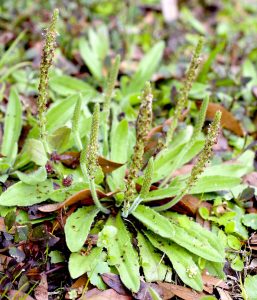
Our native Plantago is small and hairy. Photo by green Deane
There are Plantains that look like tough bananas and there are Plantains that are low and leafy plants. No relation. Just two different groups with the same common name. Plantains can be native or non-native. The one pictured right is native, the Dwarf Plantain, one of the very few North American plants to become invasive in Asia. As a genus the plants are well-known. The leaves are edible raw when young. As they age they become more bitter and stringy. Cooking makes them palatable up to a point. Then they move into the astringent medical realm. They are used on bites, stings and to help puncture wounds heal. Seeds are edible once produced and are the source of the commercial dietary fiber psyllium. When finely ground and flavoring added the seeds are sold under the brand name Metamucil. There are numerous species of Plantagos (Plantains) with at least four common locally, P. virginiana, P. major, P. lanceolata and P. rugelii the latter which strongly resembles P. major. except the bottom ends of the stem are pink.They are all used the same way. You can read about the Plantains here.
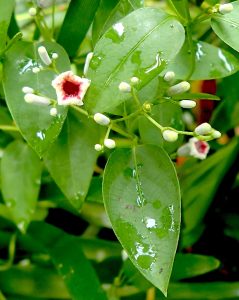
Skunk Vine lives up to its name. Photo by Green Deane
Perhaps as a last gasp — virtually — some Skunk Vine was blossoming this past week (along with some Black Cherries. Skunk Vine is aptly named though its aroma drifts more towards bathroom than skunk. However the tough vine is something of a nutritional powerhouse with some of the good chemicals one finds in the Brassica family. You can eat it raw but if you cook it outside is recommended. Oddly it was intentionally brought to Florida to make rope. This was done just before 1900 when a lot of ships were still carrying sails and five miles of rope. Ground zero was the USDA Brooksville Field Station in Hernando County Fl. Yes, this invasive vine — like many other species — was imported by the United States Department of Agriculture. Thirty-six years later it was all over Florida but it took until 1977 for it to be a recognized invasive (long after it had crawled into other southern states.) While the blossoms are attractive we eat only the leaves and young tips. You can read about Skunk Vine here.
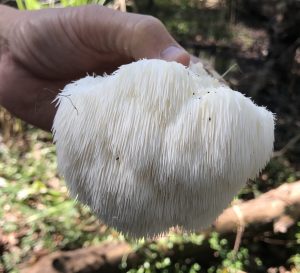
Lion’s Mane is tasty and medicinal. Photo by Green Deane
We are shifting mushrooms seasons from terrestrial to trees or better said ground to wood. Instead of looking down we now look up. Milk caps and chanterelles are giving way to Oysters, Lion’s Mane and Chicken of the Woods. Edible fungi that like wood also often like cooler weather but not exclusively. There are oysters and chickens other times of the year but cool time is prime time. Lion’s Mane is one I see only after the season starts to turn cooler and only down to northern Florida. It’s a choice find. To my pallet raised on the coast of Maine it tastes like crab or lobster and I use it in similar ways. This particular specimen was found in a foraging class in Jacksonville. You can read more about it here.

Green Deane videos are now available on a USB.
My nine-DVD set of 135 videos has been phased out and replaced by a 150-video USB. The USB videos are the same videos I have on You Tube. Some people like to have their own copy. The USB videos have to be copied to your computer to play. If you want to order the USB go to the DVD/USB order button on the top right of this page or click here. That will take you to an order form. I’d like to thank all of you who ordered the DVD set over the years which required me to burn over 5,000 DVDs individually.

Green Deane Forum
Want to identify a plant? Perhaps you’re looking for a foraging reference? You might have a UFO, an Unidentified Flowering Object, you want identified. On the Green Deane Forum we — including Green Deane and others from around the world — chat about foraging all year. And it’s not just about warm-weather plants or just North American flora. Many nations share common weeds so there’s a lot to talk. There’s also more than weeds. The reference section has information for foraging around the world. There are also articles on food preservation, and forgotten skills from making bows to fermenting food.
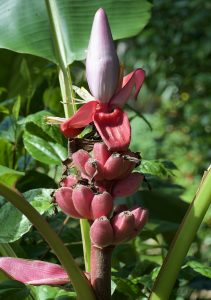
The edible, cold hardy, Pink Banana. Photo by Green Deane
In a recent video on Tropical Almond I mentioned it is not that tropical being able to live in zones 10 and 11. There is a banana that will survive in zone 7b. It will die back there but come back every year: Musa velutina.
Unlike most bananas M. veluntina can fruit in one year rather than the usual two years and can take a frost. It also lets you know when it’s ready to be eaten by peeling itself. The species does have a lot of hard seeds which are edible if rendered soft by cooking. Tall and showy with its neon fruit they were a favorite of my great grandmother, one May Eudora Dillingham (she had the bananas as a child and also claimed to have once heard President Lincoln give a speech.) Her family was into shipping and was related to the Dillinghams of commercial ventures Hawaii. In fact one Benjamin Franklin Dillingham from Cape Cod was stranded in Hawaii after trying to ship bananas to California.) Also called the Hairy Banana, Pink Banana and Pink Velvet Banana, the stubby fruit is covered with fine hair. They have a sweet and slightly tangy taste. Where can you find some, you might wonder?
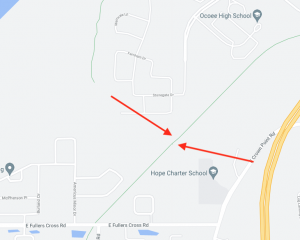
Pink Banana location
The West Orange Bike Trail west of Orlando wends its way through Winter Garden and Ocoee. The northbound trail crosses East Fuller Cross Road then descends northeast a few hundred feet to traverse a small unnamed brook (further up the hill is Ocoee High School.) For several hundred feet along the trail before and after the brook, if you look carefully, you’ll see dozens of M. veluntina growing and fruiting on both sides of the trail. I imagine some were tossed out with yard trash long ago and have kept reseeding. Enjoy.
This is my weekly newsletter #481. If you want to subscribe to this free newsletter you can find the sign-up form in the menu at the top of the page.
To donate to the Green Deane Newsletter click here.


Hi Green Deane, I’m glad to hear that you’re working on a book and more videos. The work that you’re doing to preserve this knowledge is not easily found elsewhere, and I trust your ability to sift through conflicting information and give us your best interpretations based on logic plus maybe a small amount of intuition. Have you thought about having volunteer interns/apprentices? They could help with taking the video footage, and–assuming they would be younger–might have the social media/marketing skills to publicize what you do to a larger audience. Have you seen @blackforager on Instagram? I think she misses giving adequate warnings sometimes that could be very important [such as the warning you give to people about puffballs, and cutting vertically to check that it’s not an amanita (sp?)] But she’s very enthusiastic and engaging. She lights a fire under people about foraging, a fun, and joyful fire. And she does some creative cooking with what she forages. It might be fun to invite her to join you on one of your field trips, and see what happens. She lives in Ohio but is originally from New England, I believe.